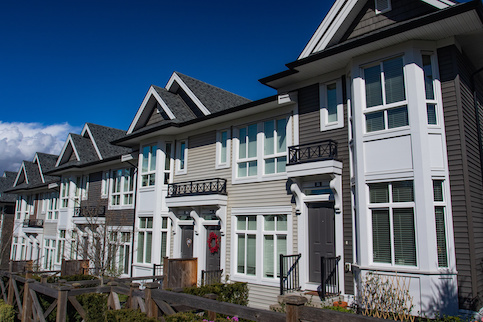If you have an interest in income producing real estate, it probably means that you’re interested in learning about all of your real estate options. You might even be amazed to learn that you can tap into a wide variety of different ways to invest in real estate, even hands-off options!
Let’s take a look at the types of real estate you can purchase as well as how to invest in income producing real estate.
See What You Qualify For
You can get a real, customizable mortgage solution based on your unique financial situation.
What Is Income-Producing Real Estate?
What is income producing real estate, exactly? Income-producing real estate is property that investors purchase as a way to make money through rent and market appreciation.
Real estate investments are a good opportunity because income-producing real estate can offer many benefits, including reliable monthly income to live off of and passive income opportunities (income that takes minimal effort to earn). Income-producing real estate can help you reach financial independence, which means you’ll have enough money to live off of without having to depend on anyone else for income.
If you’re interested in receiving regular cash flow, real estate investors may want to consider all the various investment opportunities we list in this article.
See What You Qualify For
Buy A Home
Discover mortgage options that fit your unique financial needs.

Refinance
Refinance your mortgage to have more money for what matters.
Tap Into Equity
Use your home’s equity and unlock cash to achieve your goals.
Types Of Income-Producing Properties
In this section, we’ll highlight some income-producing real estate opportunities for investors that can generate revenue. Whether you think you might want to generate rental income or live off dividends from real estate investment trusts (REITs) or another method, check out the full list just to understand your options.
Real Estate Investment Trusts (REITs)
When you invest in publicly traded real estate investment trusts (REITs), it’s like buying stock in any other public company. A REIT is a company that owns a portfolio of income-generating real estate properties.
REITs are required to pay out at least 90% of their taxable income back to shareholders in the form of dividends, which regular stocks don’t offer.
REITs own or finance income-producing real estate such as commercial real estate (offices, warehouses, shopping centers, hotels) or other areas of the real estate market, such as apartment buildings. You may also be able to invest in mortgage REITs that pay dividends for income earned from interest.
You can purchase shares of REITs through a broker. They‘re listed on major stock exchanges.
Through REITs, you can tap into good returns, and you don’t have to own physical property to invest. They are also a more liquid asset than owning physical property. On the other hand, REITs might have high fees and high taxes.
Share prices are influenced by market conditions. You also have little control over the management of a REIT. It’s a good idea to understand the risks before you invest.
Crowdfunding
Crowdfunding allows many investors to pool their money and invest in real estate as a group. Typically, investments range from $10,000 – $20,000, but the minimum buy-in can be as low as $100 depending on where you live and where the property is located.
You can join a real estate crowdfunding platform such as Fundrise, RealtyMogul, Yieldstreet, EquityMultiple or CrowdStreet and follow the crowdfunding instructions to get started.
Crowdfunding gives you access to a large number of opportunities and adds diversification to your portfolio. It also offers you a passive investment strategy. However, there are downsides like a lack of control over the underlying investment. They’re also illiquid, which means that it can be difficult to sell these properties if you suddenly need cash.
Single-Family Rentals
Single-family homes are homes that exist on their own lots. You can purchase a single-family rental in order to rent to a single tenant or family. Purchasing a single-family rental looks a lot like purchasing a primary residence.
First, you’ll get preapproval for a mortgage loan, calculate the potential returns on several properties, find the right rental property to invest in, then hire a property manager (if you don’t plan to do the property management and maintenance yourself). You will need to be able to successfully calculate the annual operating expenses and potential return.
The benefit of purchasing single-family rentals is that you may draw long-term tenants due to the fact that you’re renting a home, not an apartment. Insurance also tends to be cheaper compared to a larger property.
However, the downsides include the fact that you’re dependent on getting tenants to rent your property. In addition to that, financing terms usually cost you more compared to if buy your home to live in as a primary residence.
Owner-Occupied Rentals (2 – 4 units)
An owner-occupied rental is a home that you live in yourself. It’s a house hacking strategy, which means you rent out extra space in your primary residence to create an income. You can then use the income to offset the expenses of homeownership and mortgage payments.
Here’s an example of how it might work: You invest in a duplex or small apartment. You live in one half or one section of the apartment and rent out the other unit(s).
What are the pros and cons of owner-occupied rentals? They often attract higher-quality tenants because bad tenants (the ones who tend to create a ruckus) know they need to live as far away as possible from the property owner.
You’ll also pay less in taxes and can get less expensive financing. The downsides include tenant reluctance to live right next door to the property owner (you) as well as the fact that you’ll give up a certain amount of privacy. Since you’re so close to tenants, you may also hear more frequent complaints about the property.
Multifamily Rentals (5+ units)
Multifamily rentals are rental units that include more than one housing unit – typically 5 or more units. You cannot get a multifamily rental with a residential mortgage. Multifamily properties with 5+ units require a commercial loan. Loan requirements for commercial loans differ from residential loans because they are underwritten based on the income a property produces.
Loan requirements often call for a net worth (excluding your primary residence) equal to the loan amount. Terms differ depending on the source. Multifamily bank loans are recourse loans, meaning the borrower is liable for the full loan amount in the event of a default. Agency loans are nonrecourse, meaning that in the event of a default, the lender can only recoup the pledged collateral (for example, the apartment building).
Agencies typically only work with multifamily borrowers who have FICO® Scores of 680 or higher (640 for veterans), though banks are somewhat more relaxed depending on their existing relationship with the customer. Recent developments in online technology have allowed some lenders to streamline the documentation process on agency loans.
Benefits to multifamily rentals include more cash flow opportunities due to more units. They also offer a gateway to scalable properties and passive income and possibility of more competition to purchase in a good rental market.
The downsides include the initial larger cost of the property. First-time multifamily buyers may have to partner with veteran investors to meet the net worth and income requirements needed. In addition, there’s also more property to manage.
Short-Term Rentals
A short-term rental property is a furnished living space that offers living space for a short period of time. It has a lease term of fewer than 12 months. It could be a single- or multifamily home, condo or townhome. You may rent these from month-to-month or anything up to 6 months. A long-term lease is usually a lease that runs more than 6 months.
The advantage of investing in a short-term rental is that you’ll offer a lot of flexibility to tenants, which could be attractive to certain tenants and might even bring more income than a long-term rental. You can also benefit from deductions and tax breaks.
However, you’ll also have to deal with less payment consistency and likely must pay the utilities. It may also take more effort to run a short-term rental, particularly when you must maintain the property.
Turnkey Properties
Turnkey properties are properties that are fully renovated that you can buy and immediately rent out. Ideally, you won’t have to spend a lot of money on maintenance or extensive renovations.
The benefit of a turnkey property is that it may be easier to finance because it doesn’t require repairs. You can also rent it out right away (for potentially more money) because it doesn’t require extensive renovation time. You might also experience lower vacancy rates because renters may be pleased by the interior of the home.
On the other hand, the downsides might include that you’ll have less control over the interior and layout of the home without incurring more costs because the property is already in great shape. Furthermore, they may be more expensive to purchase outright. It might be a higher investment for you. This means it also might take longer to increase the market value of the property.
Wholesaling
Wholesaling in real estate means that investors find undervalued properties and put them under contract with a seller. Wholesalers find investors interested in the property and sell the contract to the investor for a fee. The investor then makes improvements to the home and either sells it for a higher price or rents it out.
Wholesaling costs investors less money upfront (in addition to no credit or cash involved) and takes less time to complete. In short, you can make more money in less time. On the other hand, you aren’t guaranteed income, may have trouble finding investors and must have a to cultivate an ongoing buyers list.
See What You Qualify For
You can get a real, customizable mortgage solution based on your unique financial situation.
How To Buy Income-Producing Real Estate
Here are the steps on how to buy income producing real estate:
- Understand your finances. What can you afford? Take a hard look at your own financial situation, such as the amount of debt you have, how much of a down payment you may need to put down, determine the closing costs and rental income and expenses. Get a sense of whether a particular real estate investment makes sense for your situation and goals.
- Conduct a market and investment analysis. Evaluate potential properties for their investment potential. You want to know current value and possible future performance of your investment. You also want to know absolutely everything about the market where you plan to buy property or invest. Check the neighborhood, property tax costs, schools, crime, job opportunities, amenities and listings and vacancies. Don’t forget to take any location depreciation into account as well.
- Decide what type of investment you’re interested in. It’s decision time. Once you’ve decided on the right type of investment for you, you can move forward with a preapproval. Keep in mind that you don’t have to invest in just one investment. You can consider investing in both REITs and short-term investments at the same time!
- Get preapproved through a lender. A preapproval is a document that shows how much a lender will offer you for a mortgage and includes the amount you may be able to get at a particular interest rate. In order to get preapproved, you can submit information about your income, assets and debts by offering pay stubs, W-2s, proof of income, account statements, other loan information and your ID. Your lender will share what they need you to submit.
- Make an offer. A good real estate agent can help you decide on the amount of money you might want to offer for the investment you’re after. Your agent can draft an offer letter as well. This can include the amount of money you want to offer. You and the seller can then negotiate the price and terms of the sale.
The Bottom Line
When looking into the types of income producing properties, you can invest in a wide in real estate in different ways. These include real estate investment trusts (REITs), crowdfunding, single-family rentals, owner-occupied rentals, multifamily rentals, short-term rentals, turnkey properties and wholesaling.
Once you’ve understood your finances, conduct a market and investment analysis and decide on the right type of investment for your needs. Next, get preapproved through your lender and make an offer on the property you want.
Take the first step toward buying a house.
Get approved to see what you qualify for.

Melissa Brock
Melissa Brock is a freelance writer and editor who writes about higher education, trading, investing, personal finance, cryptocurrency, mortgages and insurance. Melissa also writes SEO-driven blog copy for independent educational consultants and runs her website, College Money Tips, to help families navigate the college journey. She spent 12 years in the admission office at her alma mater.












